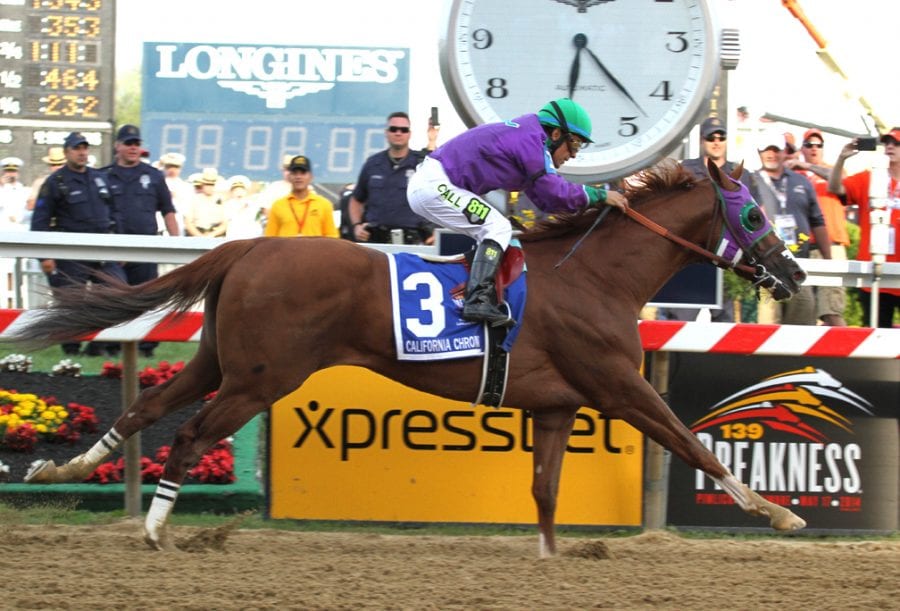
California Chrome continued a 10-year streak of Preakness winners not winning the Belmont. Photo by Laurie Asseo.
by Frank Vespe
It’s no secret that one of the challenges facing American Pharoah in his bid for the Triple Crown tomorrow is, well, fatigue.
No horse has done the Preakness-Belmont double since Afleet Alex in 2005 — and, oh by the way, his son Materiality will be aiming to play spoiler tomorrow — but that only touches on the problem. (In fairness, Da’ Tara sort of did; he ran in the Barbaro Stakes on the Preakness undercard before winning the 2008 Belmont.)
In fact, while Andrew Beyer argues persuasively that current breeding fashions — which emphasize speed and precocity over the ability to get a route of ground — are a major factor in our lengthy Triple Crown drought, you have to wonder if Cam Gambolati was onto something, too.
Gambolati, perhaps best known for conditioning Spend a Buck to the 1985 Kentucky Derby — and then skipping the Preakness to run for (and win) a hefty bonus in the Jersey Derby — told Teresa Genaro that the he believes trainers are a key component in the triple drought.
“Nowadays, trainers prepare horses for the Kentucky Derby; they don’t prepare them for the Triple Crown,” he said. “They don’t season the horse enough to run three times in five weeks. It’s all for the Kentucky Derby.”
That shuffling of trainer priorities has led to a shuffling of races. The Peter Pan, for example, the traditional Belmont prep, used to be run the week after the Preakness, two weeks before the Belmont; now it’s the week before the Preakness, four weeks out from the Belmont.
Which is to say we won’t soon see a horse do what Lemon Drop Kid did in 1999: pull off the Peter Pan-Belmont double in the space of 13 days.
Indeed, it’s not just the Belmont winner’s circle that is increasingly devoid of Preakness runners; it’s the Belmont starting gate.
From 1998 to 2005, 49 horses, more than 61 percent of Belmont starters, had made their prior start within 21 days of the Belmont. Every year but one in that period, at least half of the starters were running back within 21 days. Five Belmont winners came from that group.
That all changed starting in 2006, after Afleet Alex — running in all three Triple Crown events — thrashed a Belmont field that included three other horses that had run on that same Pimlico card and four runners that had run subsequent to that at Belmont.
Since then, just 27 Belmont starters (27 percent of total Belmont starters in the period) have run on Preakness day (or closer to the Belmont). In every year but one in this period, fewer than 50 percent of Belmont starters had run within 21 days of the final jewel; the lone exception, interestingly, was 2008, when Da’Tara won — the only one of those 27 horses to do so.
Does that mean that horses can no longer do a Preakness-Belmont double?
Not necessarily. Though it’s been six years since a horse won the Belmont after racing within 21 days prior, only 16 have attempted to do so. An 0-for-16 skid is hardly outrageous for a feat that even in its “golden years” was happening about once in 10 tries (5-for-49). (Even if you limit it to a Preakness-Belmont double, that only adds six more horses to the skid).
At some level, what’s changed isn’t that horses aren’t winning the Belmont 21 days after a race; it’s that they’re not showing up in the Belmont.
Which suggests that Gambolati might be onto something.






